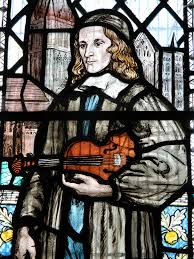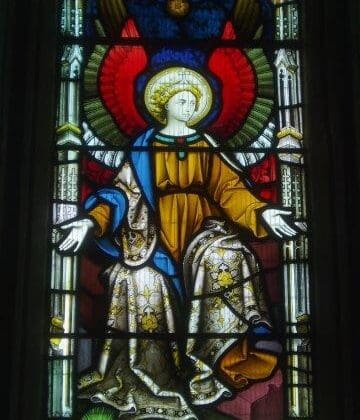GEORGE Herbert was born in 1593, the fifth son of a noble father and a saintly mother. George was a noted classical scholar at Trinity College, Cambridge, and aspired to a post in the royal court; however, his hopes for worldly promotion died along with James I, and he prepared to enter holy orders. When some friends objected to this course as being beneath his dignity, Herbert replied:
It hath been formerly judged that the domestic servants of the King of Heaven should be of the noblest families on earth. And though the iniquity of the late times have made clergymen meanly valued, and the sacred name of priest contemptible; yet I will labour to make it honourable, by consecrating all my learning, and all my poor abilities to advance the glory of that God that gave them. . . . And I will labour to be like my Saviour, by making humility lovely in the eyes of all men, and by following the merciful and meek example of my dear Jesus.
After serving ten years as a deacon, he was called in 1630 to become rector of the village parish of Bemerton, just outside Salisbury. The parish was no plum; nevertheless “the apprehension of the last great account, that he was to make for the cure of so many souls, made him fast and pray often, and consider for not less than a month: in which time he had some resolutions to decline both the priesthood, and that living.” But finally he accepted and was ordained priest.
Like his Master, Herbert had only three years of active ministry before succumbing to tuberculosis in 1633. In those three short years, the “Holy Mr. Herbert” made such an impression on those near and far that the “odour” of his life has wafted into the annals of the saints (note February 27 in the Episcopal calendar).
On his deathbed Herbert sent his friend Nicholas Ferrar a “little book” of poems, “a picture of the many spiritual conflicts that have passed betwixt God and my soul, before I could subject mine to the will of Jesus my Master: in whose service I have found perfect freedom.” This collection, called The Temple, contains some of the finest English verse ever written. Several of these poems appear in our hymnal.
Herbert also wrote a pastoral manual called The Country Parson: “I have resolved to set down the Form and Character of a true Pastor, that I may have a Mark to aim at: which also I will set as high as I can, since he shoots higher that threatens the Moon, than he that aims at a Tree. Not that I think, if a man do not all which is here expressed, he presently sins, and displeases God, but that it is a good strife to go as far as we can in pleasing of him, who hath done so much for us.”
For Herbert the key to the pastoral ministry was the pastor’s own life: “The Country Parson is exceeding exact in his Life, being holy, just, prudent, temperate, bold, grave in all his ways.” Herbert was insistent that social status and manners not distance the pastor from country people: “The Parson’s yea is yea, and nay, nay: and his apparel plain, but reverend, and clean . . . the purity of his mind breaking out, and dilating itself even to his body, clothes, and habitation.”
The pastor is to be a man of prayer, keeping the daily offices as well as periods of private prayer. Herbert saw Sunday as the pastor’s great “Market Day,” preaching and leading services in the morning, catechizing in the afternoon, reconciling neighbors and visiting the sick in between times (there was no Sunday football in Herbert’s day). Worship is no rote affair: before administering Communion, the priest is to prostrate himself before the throne of grace, acknowledging his own unworthiness. Finally, Herbert has a lovely chapter entitled “The Parson Blessing,” a practice that particularly endeared him to his congregation at Bemerton.
Community and Gospel
As is still often true today, the country priest was the most knowledgeable in the community, and he is to use his knowledge in the service of the Gospel: “The Country Parson preacheth constantly, the pulpit is his joy and his throne.” His preaching is always to be based on the Bible, “the book of books, the storehouse and magazine of life and comfort . . .” and his sermons should be aimed at his flock’s level of understanding. Herbert was a great collector of folk proverbs and he often used illustrations from agriculture and industry: “by these and other means the Parson procures attention; but the character of his Sermon is Holiness: he is not witty, or learned, or eloquent, but Holy.”
The purpose of a sermon is to inflame, but the parson’s task is also to inform. He catechizes not just the children of the parish but all ages, using what might now be called the inductive method. His regular weekday parish calls became an occasion for instruction: “When he comes into any house, first he blesseth it, and then as he finds the persons of the house so employed, so he forms his discourse,” admonishing the idle and warning the industrious not to become too deeply immersed in worldly affairs.
The priest is to be a “Father,” to serve as Christ’s “Deputy,” “to desire to be all to his Parish.” As such he cannot be a specialist. He needs to be ready to serve as lawyer, doctor, and counselor, and almoner to his people. We may feel that Herbert was indifferent to what we call lay ministry, but he can, at least, serve to remind us that there is no dishonor in being a “general practitioner” in parish ministry.
To read Herbert’s Country Parson looking for “helpful hints for rural ministry” would miss the main point of his art, which is to “turn delight into a sacrifice.” If we really want to learn from him, we must be ready to hear our Master say: “Take up your cross and follow me.”
FOR FURTHER READING
George Herbert: The Country Parson, The Temple (Paulist Press, 1981)
Isaak Walton, Lives (Oxford University Press)
Chana Bloch, Spelling the Word: George Herbert and the Bible (University of California, 1985)
This essay was first published in Trinity’s journal Mission & Ministry in the late 1990s.
Copyright Stephen F. Noll 1999.





